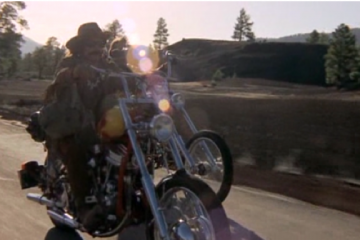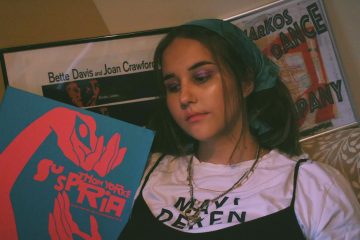The 1969 advertising tagline for Easy Rider (1969) reads “a man went looking for America and couldn’t find it anywhere”. The tagline ties the film directly to the counterculture’s rejection of mainstream American capitalist society and the oppressive class structures found therein. Barbara Klinger notes how this desire manifests across two major national discourses of the late 1960s; namely, the tension between the ‘the traditional and the transitional’ (Klinger 199). This tension can be found in the mise-en-scene of Easy Rider, especially in the scene where Wyatt and Billy visit a farmstead in Arizona.

The location is chosen to signify the idyllic roots of America in the rugged, rural Southwest. While repairing a motorbike tyre at a farmer’s stable, the costumes of the characters offer a stark comparison between the youth hippie culture and the inhabitants of the American frontier whose traditions have been appropriated and romanticised by the counterculture movement. The farmers wear wide-brimmed cowboy hats and denim clothes, traditional workwear associated with the Southwest. Their clothing is indicative of a humble life in contrast to earlier scenes featuring a decadent Los Angeles drug dealer, and their ‘blue collar’ shirts reflect their working class experience as well as the idealization of good honest hard frontier work in the pursuit of the elusive ‘American Dream’. Wyatt and Billy, named after mythical western frontier legends Wyatt Earp and Billy the Kid, seem like caricatures in comparison. Billy wears excessive tassels to evoke western legends such as Davy Crockett, whereas Wyatt sports a big US flag on the back of his jacket (Fig. 1). Both costumes represent alternatives to capitalism: the first an authentic connection to American history and the iconography of the Western; the second, a more contemporary, though perhaps illusory, idea of freedom. The bold, obtrusive colours of the (ironically worn) flag disrupt the neutral tonality of the setting, introducing a jarring artificiality to the natural landscape surrounding them. This reflects the counterculture movement’s rejection of conservative values and their lurid adoption of a more hedonistic lifestyle, especially considering the drug money that the characters carry with them. Whilst Billy’s costume affectionately mimics the workwear worn by the farmers, and in turn the individual prosperity promised by the American Dream, Wyatt’s costume rejects this idea of conformity in favour of a more radical, libertarian sense of freedom. In this sense, the tensions within the mise-en-scene reflect the social unrest at the time of the film’s release, provoked by political assassinations, US military violence in Vietnam and the struggle for civil rights. Therefore, the clashing imagery of traditional and transitional create a conflict in the seemingly impossible vision of America that the characters desire, espousing Klinger’s suggestion that ‘[their] denunciation of society is fraught with contradictions’ (Klinger, 199).

This tension is also found in the shot of the farmers tending to a horse whilst the protagonists change a tire (Fig. 2). The iconic Harley Davidson motorcycles used throughout the film are noisy, gasoline-consuming and self-consciously stylised; mimicking the counterculture movement’s disruption of conservative values. The horse, in contrast, symbolises the humble and labour-oriented lifestyle of the farmers and their connection to the land, and to nature, in addition to representing a more outdated mode of transportation, before the industrial innovations of motor vehicles and the subsequent consumerism frenzy that followed. Wyatt and Billy’s motorcycles helped to bring custom ‘chopper’ motorcycles into the mainstream, popularising what Klinger identifies as the ‘rebellious masculinity’ in 1960s popular culture (Klinger, 195). By placing both the motorcycle and the horse in the same frame, a juxtaposition is encouraged between countercultural individualism (expressed via customization and ceaseless movement) and pioneer individualism (expressed via conservative tradition and self-sufficiency). The considerable amount of distance between the two groups in the frame implies a disconnect between the two different ways of life. In this sense, the immense contrast between the tradition and transitional versions of American freedom, represented through their vehicles, ridicules the notion of one united ‘American Dream’. The shiny metal of the motorcycle (not to mention its cargo of high quality cocaine) stands out amongst the hay and soil in the barn, emphasising the completely disparate ways of life that have nothing in common, apart from the label of being uniquely ‘American’.

After dining with the farmer’s family, a montage sequence demonstrates the vast rural landscape of the Southwest as Wyatt and Billy continue their journey on the road. Shots of sunlight shining through the trees and the golden natural lighting (Fig. 3) exhibit nostalgic visions of America’s historical past, reflecting common tropes of the Western genre which serve to romanticise the rural roots of the United States. The physical grandeur of the environment, devoid of industrialisation or human influence, seems to promise Wyatt and Billy hope for the freedom that they are searching for. However, Cohan and Hark suggest that ‘while the bikers’ being on the road testifies to their apparent freedom, […] they themselves represent an incoherent conjunction of modernity and tradition’ (Cohan and Hark, 3). The simple, racially-blended lifestyle of the farmer’s family, paired with the untouched natural beauty of the location, exemplifies an interpretation of ‘freedom’, in which hard work and individualism allow a peaceful life away from the oppressive class structures of the cities. In comparison, Wyatt and Billy’s disruption of this natural simplicity and their contradictory costumes suggests their inability to settle into such a lifestyle, especially considering the farmstead’s inability to indulge in the hedonistic world of drugs and sexual freedom that the film goes on to demonstrate.
Benshoff and Griffin define the American Dream as the ‘freedom to pursue happiness without socio-economic class barriers’ (Benshoff and Griffin, 167). For Wyatt and Billy, this freedom from the rigid capitalist class structure manifests in both the traditional vision of America exhibited through popular Western mythology and iconography, and the transitional, rebellious hippie culture of the 1960s. Through the use of mise-en-scene, the film suggests these alternatives co-exist, exemplified by the jarring contrasts in lifestyle, clothing and transportation at the farmstead, but also the easygoing and cooperative nature of the interaction. By opting to take the mysterious journey promised by the road over settling for the hard-working lifestyle of the farmers, the protagonists are depicted as misguided, as it will ultimately lead them towards what will come to be a dead end. In this sense, Easy Rider casts a critical eye over the countercultural desire to ‘tune in, turn on, and drop out’, proposing no feasible happy ending for those who seek this route.
References
Benshoff, H. and Griffin, S. ‘Part III: Class and American Film’ in America on Film. West Sussex: Wiley-Blackwell, 2009, pp. 167-209. Print
Cohan, S. and Hark, I.R. ‘Introduction’ in The Road Movie Book. London: Routledge, 1997, pp.1-14. Print.
Klinger, B. ‘The Road to Dystopia’ in The Road Movie Book, ed. Steven Cohan and Ina Rae Hark. London: Routledge, 1997, pp. 179-199. Print.

Georgia Bradburn is a BA Hons Film Student at QMUL. Originally from Manchester, she has a passion for experimental filmmaking and writing, and hopes to pursue a career in directing. She currently writes essays for her blog, the Autistic Film Critic.
Please obtain permission before redistributing. Copyright © Georgia Bradburn 2020